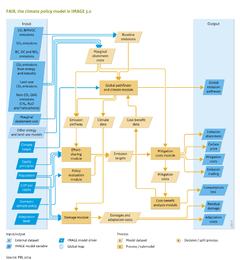Climate policy/Data uncertainties limitations: Difference between revisions
Jump to navigation
Jump to search
m (Text replace - "DataAndLimitation" to "DataUncertaintyAndLimitation") |
No edit summary |
||
| Line 4: | Line 4: | ||
For each of the FAIR modules, there are different main uncertainties: | For each of the [[FAIR model|FAIR]] modules, there are different main uncertainties: | ||
* For the cost module, the main uncertainties are future business-as-usual emission trends (higher emission trends imply higher costs to achieve a certain target) and MAC curves (it is very difficult to estimate the costs of reducing emissions in the far future). | * For the cost module, the main uncertainties are future business-as-usual emission trends (higher emission trends imply higher costs to achieve a certain target) and [[MAC]] curves (it is very difficult to estimate the costs of reducing emissions in the far future). | ||
* For the pathfinder module, uncertainty in the climate sensitivity of the climate system to greenhouse gas concentration is an important source of uncertainty, although this can be covered by using a probabilistic version of the MAGICC climate model. Probably the largest source of uncertainty relates to climate change damage, as literature on the financial damage of climate change on a global or regional scale is limited. | * For the pathfinder module, uncertainty in the climate sensitivity of the climate system to greenhouse gas concentration is an important source of uncertainty, although this can be covered by using a probabilistic version of the [[MAGICC]] climate model. Probably the largest source of uncertainty relates to climate change damage, as literature on the financial damage of climate change on a global or regional scale is limited. | ||
* One important limitation of the climate policy module is that the costs of climate policy are not being fed back to other parts of the system. | * One important limitation of the climate policy module is that the costs of climate policy are not being fed back to other parts of the system. | ||
* Furthermore, some abatement technologies, especially in the land system, are assumed to have no effects on other parameters, such as crop yields, and although some land-based mitigation technologies (afforestation, and agricultural carbon management) are included in FAIR, they are not represented explicitly in the terrestrial vegetation system of IMAGE. | * Furthermore, some abatement technologies, especially in the land system, are assumed to have no effects on other parameters, such as crop yields, and although some land-based mitigation technologies (afforestation, and agricultural carbon management) are included in FAIR, they are not represented explicitly in the terrestrial vegetation system of IMAGE. | ||
}} | }} | ||
Revision as of 17:51, 10 December 2013
Parts of Climate policy/Data uncertainties limitations
| Component is implemented in: |
|
| Related IMAGE components |
| Models/Databases |
| Key publications |
